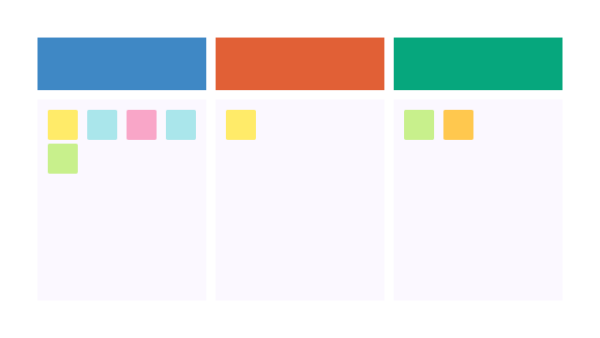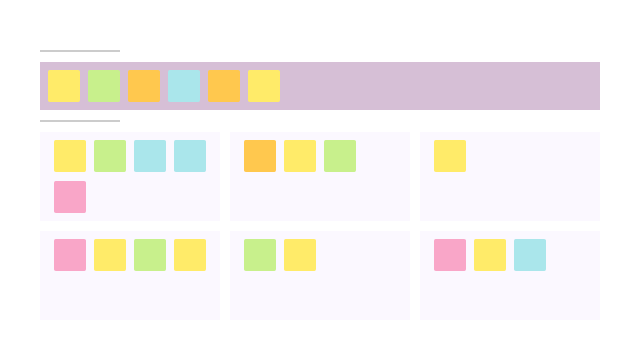The principal goal of almost every business is attracting customers and driving profit. This is no secret, and some of the most successful companies make an effort to put the intentions and priorities of the customer first. How then, do you plan around what your customer wants Using various versions of a customer journey map helps teams identify, empathize, and target their customers in ways that position them toward their specific customer-facing goals.
This article will talk about what customer journey maps are, why they’re so important, and some common applications through IdeaScale Whiteboard. Check out our guides to online whiteboards and visual collaboration if you want to learn more about how IdeaScale Whiteboard enables collaboration for teams everywhere.
What is a Customer Journey Map?
A Customer Journey Map serves as a dynamic visualization, illustrating the intricate pathway customers traverse when engaging with your product or service. Unlike mere records of tangible actions, our Customer Journey Map meticulously captures the nuances of customer assumptions, motivations, and emotions at every interaction. This strategic tool is a compelling narrative that unfolds the complete story of a customer’s experiences across all touchpoints with our brand.
Distinguishing between a Customer Journey Map and the process of Customer Journey Mapping is crucial. Our map functions as a comprehensive template, delineating the precise steps and actions that define the principal user’s journey. Meanwhile, Customer Journey Mapping, as a proactive and iterative process, entails deciphering customer actions and motivations, offering a visual representation that goes beyond the ordinary.
Our meticulously crafted Customer Journey Map is more than a static guide; it’s the cornerstone for strategic decision-making. By understanding and optimizing each stage of customer interaction, we not only elevate their experience but also set the stage for unparalleled brand affinity and loyalty.
Importance of Customer Journey Map
Customer journey mapping is all about understanding your customer’s intentions and creating the most optimal user experience while interacting with your brand. In order to both attract new customers and maintain loyalty with the ones you currently have, optimizing your customer experience is vital.
Creating a unique, personalized, and effective customer experience increases the value of your brand to new and existing customers. This experience can create important actions depending on the specific endpoints different customers interact with and you customize their experience.
Revealing the different scenarios where customers interact with your product/service and their reasons for doing so helps create a better understanding of why they are using your product/service. Having a clear understanding of these reasons allows you to target different sectors of your potential customer base with different strategies to best turn use into conversions.
Customer journey mapping is a key point of interest with the end goal of improving customer experience, and without mapping their intentions and actions it can be easy to mislead the experience provided to the customer. For that reason, customer journey mapping is a vital step in determining how to target your customers effectively.
Learn more: Experience Map vs. Customer Journey Map
Examples of Customer Journey Maps to Elevate User Experience
1. Storyboarding: Crafting Seamless Experiences for Higher Engagement
Storyboarding stands as a fundamental method in customer journey mapping, offering a dynamic approach to understand and improve user experiences. Begin by defining the scenario under examination, setting clear collaboration parameters, and establishing boundaries for focused contributions.
Break down each step of the user’s journey explicitly, aiming for simplicity. This allows for a granular examination of user emotions and intentions at every touchpoint. Storyboarding, a crucial technique for those new to customer journey mapping, is versatile and applicable to a wide range of customer-facing scenarios.

2. Persona Diagrams: Illuminating Customer Identities for Targeted Engagement
While not the most conventional approach, persona diagrams are powerful tools for delving into customer identity and traits. Unraveling your customer’s persona provides valuable insights into their motivations for using your product or service.
Persona diagrams encompass various aspects of your principal user, including their description, goals, attitudes, feedback, and solutions to their issues. This nuanced understanding enables precise targeting of customer needs, facilitating more effective communication and personalized interactions.
3. Customer Experience Map: Navigating Emotions and Impressions for Enhanced Satisfaction
Differing from maps focusing solely on specific actions, the customer experience map centers on the emotions and impressions felt by customers throughout the process. Select a scenario for analysis and deconstruct what customers need to learn, use, and remember.
By pinpointing the elements you want customers to use, learn, and remember, you not only shape the experience but also influence how customers interpret changes. Addressing these interpretations is crucial for refining your solution and filling any existing gaps in customer experience.

4. Engaging New Customers: Strategic Approaches for Attracting and Retaining Audiences
When envisioning the journey of potential users, consider not just existing customers but those you aim to attract. The Engaging New Customers board focuses on reaching and meeting the needs of prospective customers at every stage.
This board enables you to plan how to reach, impress, engage, and encourage the return of new customers. By dissecting their interaction stages, you can align your strategies with their intentions, providing a tailored experience to optimize their journey.
While not a traditional customer journey map, the Engaging New Customers board is invaluable for understanding the assumptions and needs of new customers. Teams seeking to break down and optimize user experiences should consider incorporating this dynamic tool into their toolkit.
Learn more: What are Customer Needs?
Customer Journey Map Process
In today’s highly competitive business landscape, understanding your customers and providing exceptional experiences is paramount. One valuable tool that can help you achieve this is the customer journey map.
This visual representation of a customer’s interaction with your product or service offers deep insights into their experiences, pain points, and areas for improvement. In this blog, we’ll guide you through the process of creating an effective customer journey map.
Step 1: Define Your Objectives
Before diving into the customer journey mapping process, clarify your goals. What are your intended outcomes with the creation of this map? Whether it’s improving customer satisfaction, increasing conversions, or enhancing user experience, a clear objective will guide your efforts.
Step 2: Identify Your Personas
Understanding your target audience is crucial. Generate in-depth customer personas to depict diverse segments of your audience. These personas will serve as the foundation for your customer journey map, as different customer types often have distinct paths.
Step 3: Gather Data
To craft a precise customer journey map, data is imperative. Collect information from various sources, including customer feedback, surveys, interviews, analytics, and customer service records. Both qualitative and quantitative data are essential for a comprehensive view of your customer’s experience.
Step 4: Outline Touchpoints
Enumerate all the points of interaction where customers engage with your brand. These could include website visits, social media engagement, email communication, in-store visits, and more. Identifying all touchpoints is a critical step in understanding the customer’s full journey.
Step 5: Create a Visual Representation
Customer journey maps are typically visual, using diagrams, charts, or software tools. A visual representation makes it easier to understand and communicate the customer’s journey.
Step 6: Plot the Stages
Divide your map into key stages that customers go through in their journey, such as Awareness, Consideration, Purchase, Onboarding, Usage, and Support. Customize these stages according to your specific business model.
Step 7: Document Customer Actions and Emotions
For each stage, detail the specific actions customers take and the emotions they experience. Understanding their mindset at each stage is essential for improving the customer experience.
Step 8: Identify Pain Points and Opportunities
During your mapping process, pinpoint areas where customers face challenges or frustrations (pain points). Simultaneously, identify opportunities to enhance the experience or add value to the customer’s journey. These insights will be instrumental in shaping your improvements.
Step 9: Link Touchpoints
Connect touchpoints to the stages of the customer journey. Determine how customers move from one touchpoint to another. This helps you understand the flow of the customer experience.
Step 10: Add Metrics and KPIs
Include key performance indicators (KPIs) or metrics related to each stage. These metrics will allow you to measure the success of your customer experience improvements.
Step 11: Share and Collaborate
Collaboration is key. Share your customer journey map with relevant stakeholders across your organization, including marketing, sales, customer support, and product development teams. Encourage input and collaboration to ensure a holistic approach to improving the customer journey.
Step 12: Iterate and Improve
Remember that a customer journey map is a dynamic tool. It should evolve as your business and customer needs change. Regularly revisit and update it based on new data and customer feedback.
Step 13: Implement Changes
After identifying pain points and opportunities, work on implementing changes to address them. This could involve changes to your website, marketing materials, customer service processes, or product features.
Step 14: Monitor and Measure
Continuously monitor the impact of your changes by tracking relevant KPIs. Collect feedback from customers to assess whether their experiences have improved.
Conclusion
Customer journey maps provide some of the most effective methods of targeting new users and optimizing their experience. If you are looking to learn more about how to target your customers and create an enjoyable customer experience then try using the boards above.
You can check out our recent article on the Lander blog to learn more about content marketing, and if you are interested in learning more about virtual workshops check out our guides on IdeaScale Whiteboard and use our boards in our web app!
Most Recent Posts
Explore the latest innovation insights and trends with our recent blog posts.













